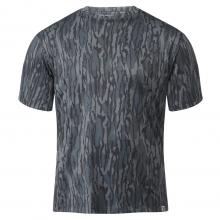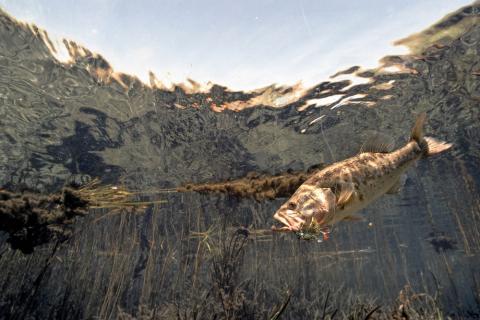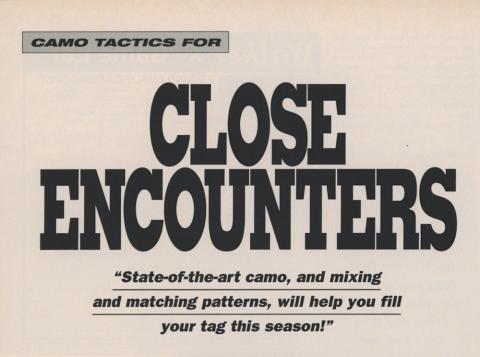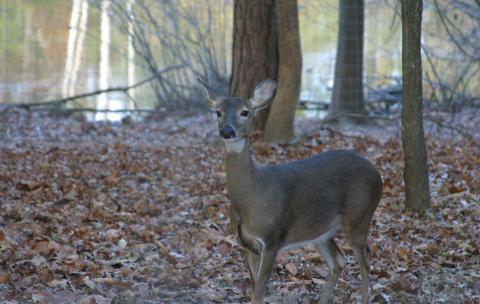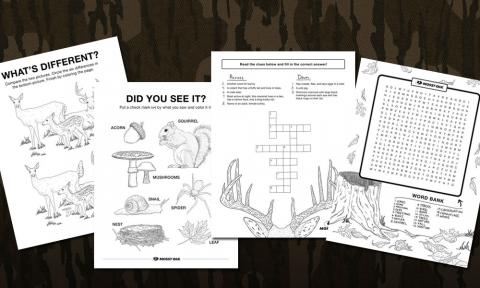Can Your Pond Handle Heavy Rain?
Barry W. Smith | Originally published in GameKeepers: Farming for Wildlife Magazine. To subscribe, click here.
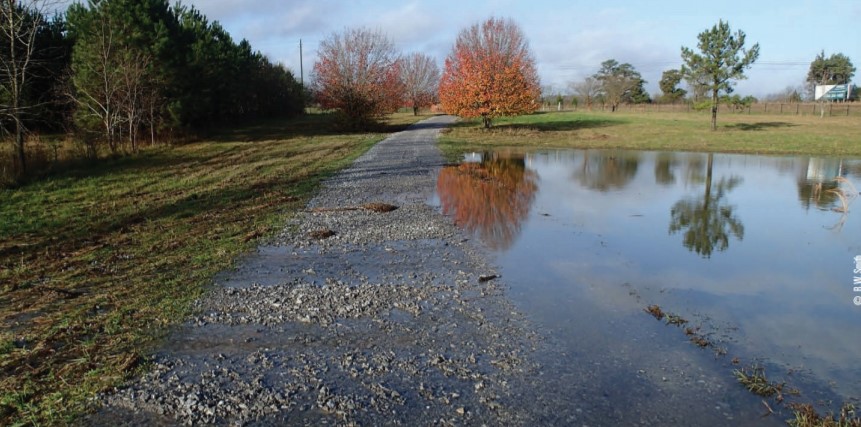
December 2015 found most of us experiencing record rainfalls. In many areas of the United States rainfall events of 10 to 15 inches occurred on top of already saturated soils. These conditions cause unusually high runoff from watersheds and can result in major erosion of unstable soils and erosion of pond dams that are not properly constructed to handle high runoff events. Water going out of ponds and lakes because of heavy rain events often ran over dams causing severe washing and in some cases dam failure and complete loss of ponds and their fish populations
Many of these problems in lakes and ponds were a result of abnormal runoff and poor pond or lake design. One of the premier pond construction experts in the Southeast is Mr. Bobby Gates of the Natural Resource Conservation Service (NRCS) of the US Dept. of Agriculture (USDA). This agency was formerly known as the US Soil Conservation Service (SCS). One of its previous missions was to provide technical assistance to land owners wishing to build a lake or pond. Gates has provided that assistance to thousands of land owners in Alabama and offered several common design mistakes that have resulted in severe erosion and/or dam failure.

"In my more than 40-year career of providing engineering advice to pond owners," says Gates, " I have seen a number of common mistakes in pond and spillway design. Many ponds are constructed without an overflow pipe, a horizontal pipe going through the bottom of the dam, attached to a larger diameter vertical pipe designed as the primary overflow apparatus." Most of the vertical overflow pipes are placed 1 foot above normal full pool and are sized to carry 95% of rain events.
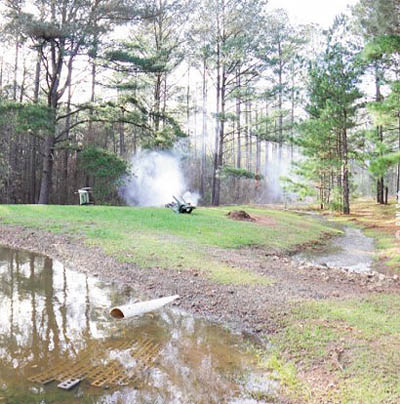
all-weather crossing by installing a pipe and covering it with
gravel. The pipe clogged with limbs and leaves causing the
water to rise and crest the dam in several places. Severe
erosion occurred but fortunately the dam did not wash out.
"Although we always design an emergency spillway, we hope that it never has to be utilized," says Gates. According to Gates, the size of the primary overflow pipe and the width of the emergency spillway depends on the size of the lake and, more importantly, the watershed ratio. The watershed ratio is the number of acres of watershed that provide rain runoff for each acre of pond. The type of watershed influences the amount of runoff. A wooded watershed has less runoff than pasture and much less than row crops. This is why it is important to consult a qualified lake engineer for advice on lake design. “We suggest two or three feet of freeboard on a lake dam depending on the size of the lake and watershed. This will contain high water inside the dam while it is being evacuated by the overflow pipe and emergency spillway. This prevents possible erosion of the dam," commented Gates.
Some landowners prefer low freeboard because they think their lake looks better with the top of the dam near the water but Gates says this is a serious engineering mistake that can cause a lot of heartache in the future. Other lake owners are looking for ways to cut costs and instead of reducing the size of the lake to fit their budget, they will want to reduce the amount of dirt needed on top of the dam to provide the necessary freeboard...another serious design mistake!
It is common for most lake dams to be used as a roadway. "The mistake many pond owners make is to place a pipe on top of the emergency spillway and cover it with rip-rap or gravel so they can drive across the spillway during rainy weather," Gates said. "This significantly elevates the level of the emergency spillway and provides a very narrow opening that can be easily clogged with limbs and leaves during a heavy rain. A 12- or 16-inch pipe cannot begin to carry the water that could flow a couple of inches deep across a 20- foot spillway."
Many new lake owners are concerned about losing their fish out the spillway during over flow. This is another good reason to properly size the primary overflow pipe so that there is seldom a flow over the emergency spillway. When water levels of 6 inches or more go out of the spillway there is always a possibility of losing fish of all sizes. The higher the water flow the greater the chance of losing adult fish. Some fish are more likely to travel with the current than others. Threadfin shad and grass carp like to leave lakes through high spillway flows. To reduce loss of grass carp, a parallel-bar spillway barrier can be placed across the spillway. The bars are usually made of 3/8 inch smooth round stock and spaced 1 inch apart and supported every four feet by vertical angle iron.
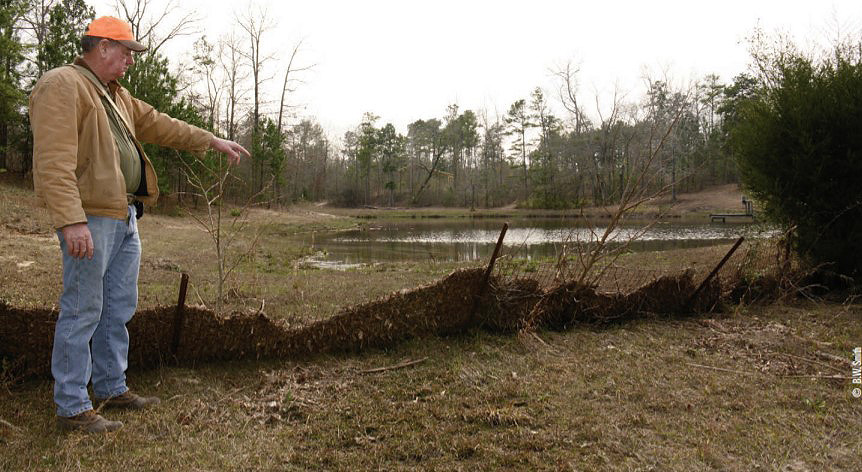
"I have seen everything from 1/2 inch hardware cloth to welded 2 X 4-inch fence across spillways," stated Gates. "The cross hatch of the wire soon clogs with leaves, grass and other debris, causing the water to rise rapidly and endangering the integrity of the dam. It is always a bad idea to fence a spillway."
Heavy rain events resulting in 6 or more inches of flow through the spillway not only provides an opportunity to lose fish from your pond or lake, but the flow acts as a corridor for wild fish, such as bull head catfish and green sunfish to enter your lake. If you look below your lake when the water is going out your spillway you will notice that the ordinary drainage ditch below your lake has suddenly developed into a flowing creek that eventually connects to the river. Numerous unwanted species of wild fish will travel up stream until they eventually reach your lake. It is not usually bird's feet that is the source of wild fish contamination but the waterway established during periods of high water outflow. Again, the design of your lake's overflow pipe and spillway, to meet the needs of your lake and water shed, plays an important part of your lake's recreational fishing success. Consult a qualified lake design engineer before building. Sometimes hiring your second cousin, who owns a bull dozer, to build your pond may not be as cheap as you think!







